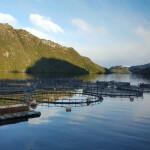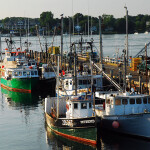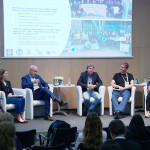There is growing awareness of the omnipresence of microplastics in the world’s oceans, but surprisingly little knowledge about their potential effect on seafood.
One of the most useful properties of plastic is its durability, but this is also a major factor in plastic presenting an environmental and human health risk when it enters our oceans, particularly as small particles. The term microplastics was introduced in the last decade to describe the small pieces of plastic found in the ocean, commonly defined as less than 5 mm in diameter.
Plastics often contain chemicals added during manufacture and can absorb and concentrate contaminants such as pesticides and persistent organic pollutants including polychlorinated biphenyls (PCBs) from the surrounding seawater. There is emerging evidence of transfer of chemicals into tissues from plastic particles ingested by aquatic life.
Microplastics enter the drainage system as microfibers laundered from synthetic clothing, as microbeads commonly used in the cosmetic and toothpaste industry, and in industrial abrasives and domestic cleaning products. They may also be created by larger debris, such as bottles, bags and other plastic litter, degrading over time.
According to Adventurers and Scientists for Conservation (ASC), which is running a global microplastics initiative, particles have been found in the vast majority of marine samples collected from as far afield as Maine, Alaska, Argentina, Thailand and Antarctica. Manmade polymers have been found in deep sea habitats down to 5,755 meters in the Northwest Pacific.
The organisation is now expanding its research to fresh water, hoping to identify the major inputs of pollution, with a goal of arresting them at their source. However, even if littering was stopped entirely, the weathering of larger particles already in the marine environment would continue to produce microplastic particles for many years to come.
The sources, fate and effects of microplastic particles on marine ecosystems was recently reviewed by the Joint Group of Experts on the Scientific Aspects of Marine Environmental Protection (GESAMP), an interagency body of the United Nations, in a report published by the International Maritime Organisation. The report found that microplastic particles are ingested by species at all levels in the marine food chain, from plankton to macro fauna. They are also found in the stomachs of fish and birds. Interactions with bacterial and algal communities have been recorded, and uptake via the gills of very fine particles (8-10 μm) has been shown to occur in shore crab. There is also evidence of microplastics in the tissues or body fluid of filter-feeders.
Willian Lart, sustainability and data advisor at Seafish, a non-departmental public body overseeing the seafood industry in the U.K., has conducted a gap analysis on the information.
Lart believes more work needs to be done to investigate possible human dietary intake of microplastic contamination in fish and shellfish and which types of microplastic particles are likely to be most hazardous. Also needed is a better understanding of the ability of microplastics to absorb pollutants, and greater information on the ecosystem effects of microplastics in terms of the extent to which they undermine ecosystem productivity and biodiversity.
Surveys of microplastics in fish to date have concentrated on gut contents rather than muscle tissue, but studies are now underway to look at this important aspect.
As for human ingestion of microplastics, studies have found tiny plastic particles can move across the human gut wall, and experimental studies on humans and rodents indicate that adverse effects may start to emerge due to interactions with cells and tissues by particles of less than a quarter of a millimetre (250 μm).
Norwegian research institute Nofima has just embarked on a four-year project to investigate how microplastic particles absorb environmental contaminants, how these influence the cod food chain, and the effects on fish.
“Results from the project will be used to develop models that simulate the absorption of environmental contaminants into microplastic, and how they influence individuals, populations and the food chain in the marine ecosystem,” explained lead researcher André Sture Bogevik.
The GESAMP report makes a number of recommendations, including bringing in expertise from the fields of pharmacology and mammalian toxicology, to give a greater understanding of the fate and consequences of nano-sized particles.
In many countries, regulations have been put in place on allowable levels of the main pollutants in seafood offered for sale, thereby controlling any potential effects. This extends to fishmeal and fish oil incorporated into the diets of farmed fish, which is carefully monitored to ensure contaminants do not travel up the food chain.
However, according to GESAMP, public and private sector awareness of the potential negative ecological, social and economic impacts of microplastics is much less developed than for macro-litter. It recommends effective engagement and education at all levels of society in a bid to raise awareness and promote positive behavior change. According to the organization, increasing awareness of microplastics is necessary to safeguard the health of the marine eco-system as well as human health.






